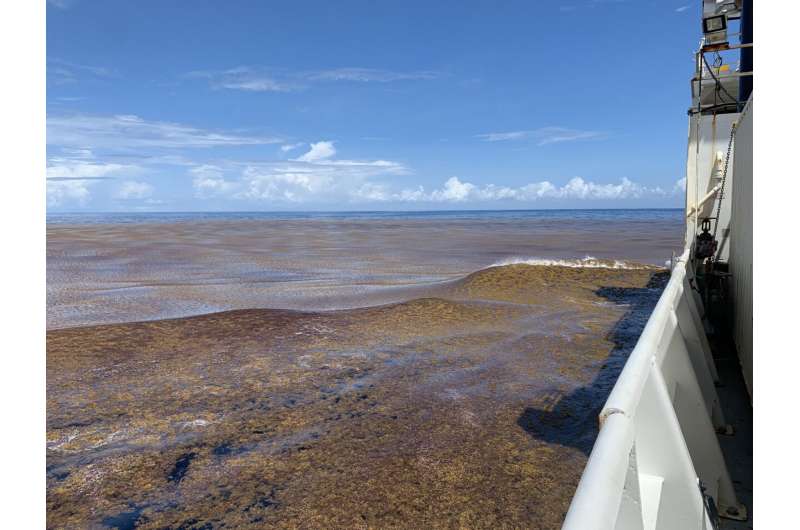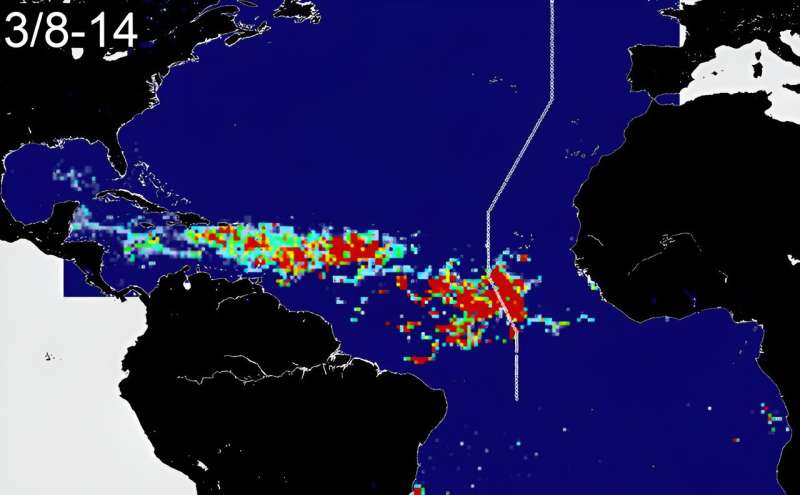This article has been reviewed according to Science X's editorial process and policies. Editors have highlighted the following attributes while ensuring the content's credibility:
fact-checked
peer-reviewed publication
trusted source
proofread
Study clearly identifies nutrients as a driver of the Great Atlantic Sargassum Belt

Under normal conditions, the floating macroalgae Sargassum spp. provide habitat for hundreds of types of organisms. However, the Great Atlantic Sargassum Belt (GASB) that emerged in 2011 has since then caused unprecedented inundations of this brown seaweed on Caribbean coastlines, with harmful effects on ecosystems while posing challenges to regional economies and tourism, and concerns for respiratory and other human health issues.
Researchers looking into the question of what is the nutrient supply for the GASB say that they have now clearly identified that the nutrient content of Sargassum tissue could help determine the enrichment sources and potentially improve predictions and Sargassum management efforts.
"We show clearly for the first time that Sargassum in the GASB is enhanced in both nitrogen and phosphorus, indicative of a healthy and thriving population," according to the journal article "Nutrient and arsenic biogeochemistry of Sargassum in the western Atlantic," published in Nature Communications.
"Stable nitrogen isotope values point to riverine sources in some circumstances and are more equivocal in others. Distinguishing the various nutrient sources sustaining the GASB will require systematic snapshots of nutrient content and isotopic composition across its entire breadth," according to the paper.
"Presumably, the closer one gets to the source, the higher the nitrogen and / or phosphorus content of Sargassum should be. In that sense, basin-wide patterns in nitrogen and phosphorus elemental composition could provide the fingerprinting necessary to unequivocally determine the sources."
The paper notes that a variety of nutrient sources for the GASB blooms have been suggested, including upwelling, vertical mixing, discharge from the Amazon and Congo rivers, and atmospheric deposition. Though, the paper states that the causes of the GASB and the mechanisms controlling its variability remain unknown.
The paper also indicates that the nutritional status of Sargassum in the GASB is enriched, with higher nitrogen and phosphorus content than are populations of Sargassum that reside in its Sargasso Sea habitat.
"In its traditional environment, Sargassum is a great ecological benefit. However, the proliferation of biomass in the tropical Atlantic has proven the old adage that too much of a good thing can be bad," said journal article lead author Dennis McGillicuddy, Jr., senior scientist in the Applied Ocean Physics and Engineering Department at the Woods Hole Oceanographic Institution (WHOI).
The finding that nitrogen and phosphorus are higher in the GASB than in the Sargasso Sea "is a smoking gun that the GASB inundations are nutrient-driven," said McGillicuddy. "A consequence of this finding is that it presents us potentially with the opportunity to use those nitrogen and phosphorus markers in Sargassum tissue to fingerprint the ultimate sources of these nutrients that are sustaining these seaweed blooms."
In addition, the paper notes that the presence of arsenic in Sargassum tissue—which reflects phosphorus limitation—significantly constrains the utilization of the seaweed biomass that washes ashore.
"As the Great Atlantic Sargassum Belt has grown over the last decade, the public has become increasingly aware of this phenomenon and its impact on coastal communities," said co-author Peter Morton, associate research scientist in the Department of Oceanography at Texas A&M University, College Station.
"Our research shows that Sargassum could become enriched in arsenic, depending on the conditions in which it grows. Plans to remove or exploit this material when it washes ashore should consider the potential for Sargassum to contain high concentrations of arsenic, so we encourage affected communities to proceed with caution when exploring options to deal with seasonal inundations of Sargassum."

Due to the threats that the Sargassum inundations pose to the environment, economy, and human health, the paper recommends the need for expanded observational and modeling studies to understand the GASB's physical, biological, and chemical drivers. The paper notes that "the societal need for scientific understanding is urgent: improved seasonal to interannual predictions would offer tremendous value for proactive planning and response, while quantification of the underlying causes could inform potential management actions to mitigate the problem."
McGillicuddy first saw Sargassum when he was a child growing up in Florida and his grandfather took him fishing near the seaweed because that was the best place to fish. "It was an oasis in the oceanic desert," McGillicuddy said.
"Now, the system has changed in a fundamental way. We've got an oceanographic process out there that is creating this. As a scientist, and as a fisherman, I feel an urgent need to try to understand this situation, not only to help answer the interesting scientific questions around this problem, but do so in a way that we are able to understand the situation and eventually mitigate it in a way that would be of value to society," he said.
McGillicuddy and co-author Brian Lapointe also stressed the importance of the interdisciplinary and collaborative nature of this research, which encompasses a number of disciplines including biology, chemistry, and physics.
"This collaborative study illustrates the value of interdisciplinary research teams to understanding complex oceanographic phenomena in an era of rapid global change, in this case, the Great Atlantic Sargassum Belt that formed in 2011," said co-author Brian Lapointe, a research professor at Florida Atlantic University's Harbor Branch Oceanographic Institute, and one of the world's foremost authorities on Sargassum.
More information: Dennis Joseph McGillicuddy et al, Nutrient and arsenic biogeochemistry of Sargassum in the western Atlantic, Nature Communications (2023). DOI: 10.1038/s41467-023-41904-4
Journal information: Nature Communications
Provided by Woods Hole Oceanographic Institution



















